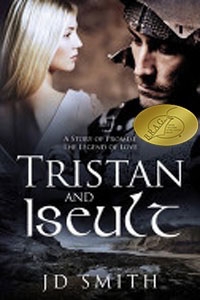 When it comes to legends of Irish princesses, don’t expect a happy ending. Their stories are decidedly tragic.
When it comes to legends of Irish princesses, don’t expect a happy ending. Their stories are decidedly tragic.
The ancient legend of Tristan and Iseult, known from at least the 12th century, is a case in point. There are many versions of the story, which is basically a love triangle. Iseult, daughter of an Irish king, is a pawn in the game of political marriages. She is wed to King Mark of Cornwall in order to cement an alliance between an Irish kingdom and Cornwell. Mark’s younger nephew and heir to the throne of Cornwall, Tristan, falls in love with Iseult, and she with him. Because of their tangled loyalties and overwhelming passion, the lives of all three end tragically.
This tale of wronged lovers, duty, and sorrow has greatly influenced many retellings, including many versions of the story of King Arthur, Lancelot, and Guinevere. In the story of Camelot, as in Tristan and Iseult’s story, the three people involved love and respect each other. They have no intention of betrayal, but their love is so strong it cannot be denied. Such love is powerful enough to incite jealousies. Even if the lovers never actually do any wrong, their downfall is inevitable because such power is dangerous.
As a whole, legends tend to focus on plot rather than character. Modern novelizations of legends go beyond the retelling of events to develop the characters. That is exactly what J. D. Smith’s version of the legend, Tristan and Iseult, does. Smith uses the alternating voices of Tristan and Iseult to bring the story to life. He shows how Iseult knows that her fate as the daughter of a king is not her own choice, and that her marriage will be a tool used by men to gain power. When she is saved from her impending marriage to the brutish King Morholt, she finds herself grateful to King Mark and impressed with his ideas of alliance and peace. In fact, she wouldn’t mind marrying him, in spite of his age, if it weren’t for Tristan.
Tristan, a warrior fighting to stem the tide of the Saxon invasion, honors and respects his uncle, King Mark. He mourns the death of his cousin, Mark’s son, and is surprised when Mark names him his heir.
Iseult and Tristan do not mean to fall in love, but they do. Smith’s version of the story shows us how such a forbidden passion can grow. He reveals the character’s inner thoughts, desires, fears and hopes, making us understand and sympathize with their dilemma, where every choice seems destined to lead only to lifelong sorrow.
Rather than the flat, archetypal character of the legend, Smith’s characters seem very real, very human. Faced with their impossible choice, can they do what is right? Will such honor bring them happiness? With simple, direct prose, Smith makes us care about these doomed lovers and the fate of their world.
Legends like this one reveal human frailty and the power of human impulses. We care for these people who, in spite of vast difference in time and culture, could be us. Even though we know their end will be tragic, we hope for the best. We hope, perhaps this time, honor will be rewarded and love will win.
Perhaps, that is why legends endure. In spite of tragic fate, that hope remains.
